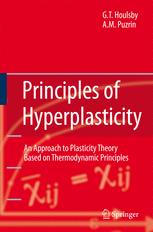

Most ebook files are in PDF format, so you can easily read them using various software such as Foxit Reader or directly on the Google Chrome browser.
Some ebook files are released by publishers in other formats such as .awz, .mobi, .epub, .fb2, etc. You may need to install specific software to read these formats on mobile/PC, such as Calibre.
Please read the tutorial at this link: https://ebookbell.com/faq
We offer FREE conversion to the popular formats you request; however, this may take some time. Therefore, right after payment, please email us, and we will try to provide the service as quickly as possible.
For some exceptional file formats or broken links (if any), please refrain from opening any disputes. Instead, email us first, and we will try to assist within a maximum of 6 hours.
EbookBell Team

4.3
28 reviewsPrinciples of Hyperplasticity is concerned with the theoretical modelling of the behaviour of solids which undergo nonlinear and irreversible deformation. The approach to plasticity theory developed here is firmly rooted in thermodynamics, so that the models developed are guaranteed to obey the First and Second Laws. Major emphasis is placed on the use of potentials, and the derivation of constitutive models for irreversible behaviour entirely from two scalar potentials is shown. It is to accentuate this feature that the authors use the term "hyperplasticity", by analogy with the use of "hyperelasticity" in elasticity theory.
The use of potentials has several advantages. First it allows models to be very simply defined, classified and, if necessary, developed. Secondly, by employing Legendre Transformations, it permits dependent and independent variables to be interchanged, making possible different forms of the same model for different applications. Emphasis is also placed on the derivation of incremental response, which is necessary for numerical analysis.
In the later parts of the book the theory is extended to include treatment of rate-dependent materials. A new and powerful concept, in which a single plastic strain is replaced by a plastic strain function, allowing smooth transitions between elastic and plastic behaviour is also introduced.
Illustrated with many examples of models derived within this framework, and including material particularly relevant to the field of geomechanics, this monograph will benefit academic researchers in mechanics, civil engineering and geomechanics and practising geotechnical engineers; it will also interest numerical analysts in engineering mechanics.